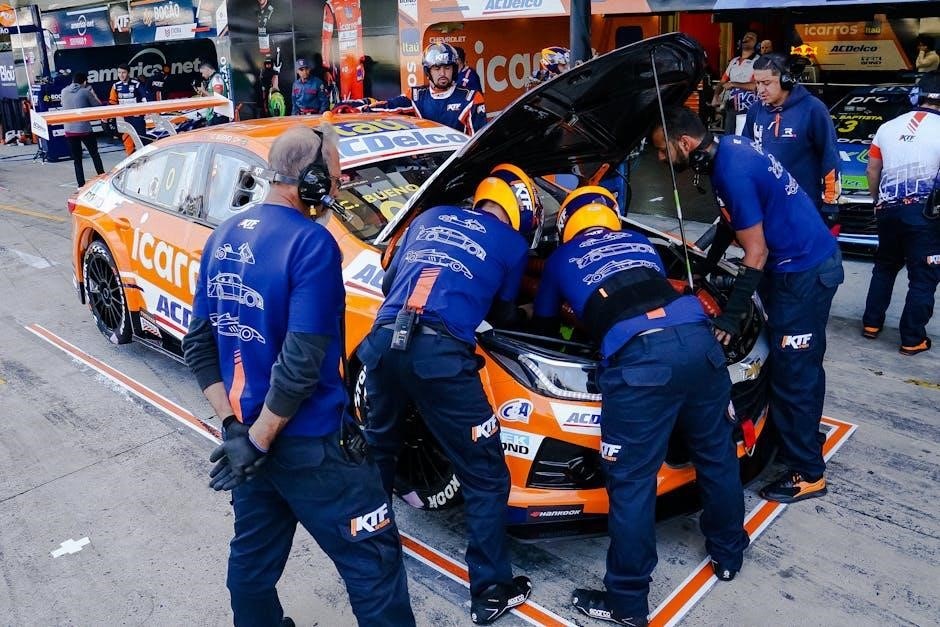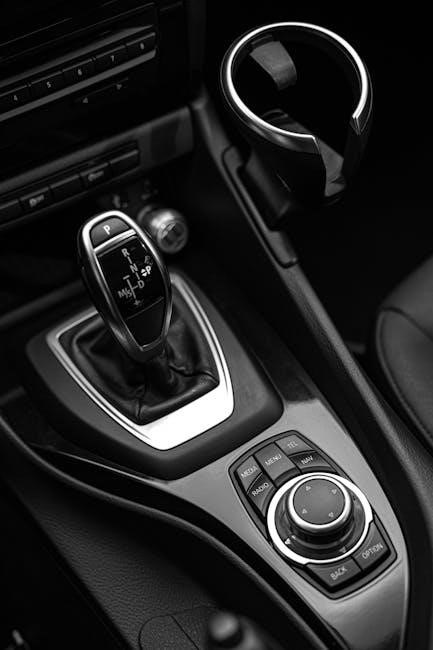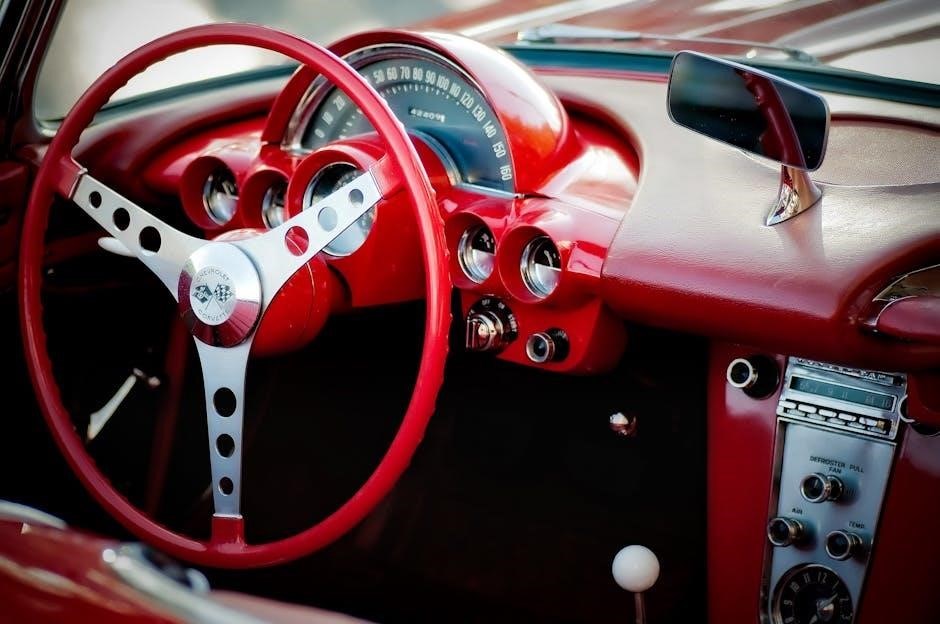The Chevy 3-speed manual transmission is a robust, three-speed manual gearbox known for its simplicity and durability. It has been widely used in classic Chevrolet models and trucks, offering reliable performance and ease of operation for drivers.

History and Evolution
The Chevy 3-speed manual transmission has a rich history dating back to the mid-20th century, with its origins in the 1940s. Initially designed for simplicity and durability, it became a staple in Chevrolet’s lineup, particularly in classic models like the Bel Air and Chevelle. Over the years, the transmission evolved to meet the demands of various applications, from passenger cars to trucks. The Saginaw 3-speed, introduced in the 1960s, was widely used in GM vehicles, while the Muncie SM319 and SM465 4-speeds gained popularity in trucks and performance cars. By the 1980s, the 3-speed began to be phased out in favor of 4-speed and automatic transmissions, but its legacy endures in vintage restorations and enthusiast communities. Today, rebuild kits and repair guides remain popular, showcasing its lasting appeal.

Components of the Chevy 3-Speed Manual Transmission
The Chevy 3-speed manual transmission consists of a gearset, bearings, synchronizers, and shift linkage. These components work together to provide smooth gear transitions and reliable performance.

3.1 Gearset
The gearset is the heart of the Chevy 3-speed manual transmission, comprising three forward gears and one reverse gear. These gears are precision-engineered to ensure smooth power delivery and optimal performance across various driving conditions. The gearset includes a cluster gear, pinion gears, and shafts that work together to provide the necessary torque and speed ratios. In classic Chevrolet models, the gearset is designed to be durable, with some transmissions lasting for decades with proper maintenance. The gear ratios are typically optimized for balanced performance, making the 3-speed transmission suitable for both city driving and highway cruising. Over the years, slight variations in gear ratios have been introduced to accommodate different engine configurations and vehicle applications.
3.2 Bearings
The bearings in the Chevy 3-speed manual transmission play a crucial role in ensuring smooth operation by reducing friction between moving components. These bearings are typically ball or needle types, designed to handle the stresses of gear rotation and shaft movement. Proper lubrication is essential to maintain their longevity, as they are subjected to constant wear and tear. Regular inspection and maintenance of these bearings can prevent premature failure, which could lead to noisy operation or complete transmission malfunction. Over the years, advancements in bearing technology have improved the durability and performance of the Chevy 3-speed transmission, making it a reliable choice for both classic and modern applications.
3.3 Synchronizers
The synchronizers in the Chevy 3-speed manual transmission are critical components that enable smooth gear shifts by aligning the speeds of the gears and shafts. These parts use friction to match the rotational speed of the gear being selected with the shaft, preventing grinding and ensuring seamless transitions. Over time, synchronizers can wear out, leading to difficult or noisy shifting. Regular maintenance, such as replacing worn synchronizer rings and ensuring proper lubrication, is vital to maintaining optimal performance. Upgraded synchronizers are also available for enthusiasts seeking enhanced shifting precision and durability in their classic Chevy transmissions.
3.4 Shift Linkage
The shift linkage in the Chevy 3-speed manual transmission is a critical mechanical system that connects the gearshift lever to the transmission, enabling drivers to manually select gears. It typically consists of a gearshift lever, linkage rods, and couplers that transfer the driver’s input to the transmission’s internal mechanisms. Proper adjustment of the shift linkage is essential for smooth and precise gear changes, as misalignment or wear can lead to difficulty shifting or incorrect gear engagement. Over time, components like the shift linkage can wear out, requiring adjustment or replacement to maintain optimal performance. Regular lubrication and inspection of the linkage are recommended to prevent issues and ensure reliable operation.

Applications of the Chevy 3-Speed Manual Transmission
The Chevy 3-speed manual transmission was widely used in classic Chevrolet models, including the Bel Air, Camaro, and various trucks, from the 1940s through the 1960s.
4.1 Classic Chevrolet Models
The Chevy 3-speed manual transmission was a staple in many classic Chevrolet models, offering a straightforward and reliable driving experience. It was prominently featured in the iconic 1955 Chevrolet Bel Air, paired with the powerful 265 cubic-inch V8 engine, making it a favorite among car enthusiasts. Similarly, the 1957 Chevrolet Bel Air Convertible showcased the 3-speed manual transmission alongside its 283 cubic-inch V8 and Carter 4BBL carburetor, blending performance with timeless style. This gearbox also found its way into the 1964 Chevrolet Chevelle Malibu SS, where it complemented the car’s sporty demeanor. Additionally, the 1964 283 Small Block Engine, often paired with the 3-speed manual, became a symbol of durability and simplicity. These classic models highlight the transmission’s enduring legacy in Chevrolet’s rich automotive history.
4.2 Trucks and SUVs
The Chevy 3-speed manual transmission was widely used in Chevrolet trucks and SUVs, where its durability and simplicity made it an ideal choice for work vehicles. The 1949 GMC FC152 pickup, for instance, featured this transmission, showcasing its reliability in heavy-duty applications. Similarly, the 1964 Chevrolet trucks, including the Square Body models, often came equipped with the 3-speed manual, offering a robust option for hauling and towing. The transmission’s straightforward design made it a favorite among farmers and construction workers who needed dependable machinery. Additionally, the 3-speed manual was paired with the 283 Small Block Engine in various trucks, further enhancing its reputation for strength and endurance. This gearbox proved to be a versatile and reliable workhorse in Chevrolet’s lineup of trucks and SUVs, making it a staple for decades.
4.3 Other Applications
Beyond passenger cars and trucks, the Chevy 3-speed manual transmission found its way into various niche applications. Enthusiasts and restorers often sought this transmission for its simplicity and ease of maintenance, making it a popular choice for classic car restorations. For instance, a 1957 Chevrolet Bel Air Convertible with a 283 C.I. V8 engine was paired with this transmission, highlighting its versatility in both performance and style. Additionally, the 3-speed manual was occasionally used in off-road vehicles, where its durability and straightforward design provided a reliable option for rugged terrain. Its presence in certain racing applications further underscores its adaptability, as builders valued its strength and simplicity for custom projects. Thus, the Chevy 3-speed manual transmission became a versatile component across multiple automotive sectors, demonstrating its enduring appeal and practicality.

Maintenance and Repair
Regular maintenance, such as checking transmission fluid and inspecting gear wear, is crucial for optimal performance. Rebuilding and repairing the Chevy 3-speed manual transmission is straightforward with proper tools and resources.
5.1 Regular Maintenance Tips
Regular maintenance is essential to ensure the longevity and smooth operation of the Chevy 3-speed manual transmission. Start by checking the transmission fluid level regularly to prevent overheating and wear. Inspect the gearshift linkage for proper alignment and adjust as needed to maintain precise shifting. Lubricate the bearings and gears periodically to reduce friction and extend component life. Additionally, monitor the clutch pedal for proper engagement and disengagement, as misalignment can strain the transmission. Finally, inspect the transmission mounts for any signs of damage or wear, as they play a crucial role in absorbing vibrations. By following these tips, you can keep your Chevy 3-speed manual transmission running smoothly for years to come.
5.2 Common Issues to Watch For
The Chevy 3-speed manual transmission, while reliable, can experience certain common issues over time. One prevalent problem is worn-out synchronizers, which can cause grinding or difficulty shifting gears. Another issue is bearing wear, leading to noise during operation. Leaks from the transmission case or tail housing can also occur, often due to seal failure. Additionally, the gearshift linkage may become misaligned, resulting in vague or unresponsive shifting. Drivers should also watch for clutch wear, as it can directly affect transmission performance. Regular inspections can help identify these issues early, preventing more costly repairs down the line. Addressing these problems promptly ensures the transmission continues to function smoothly and efficiently.
5.3 Step-by-Step Rebuild Guide
A rebuild of the Chevy 3-speed manual transmission requires careful planning and attention to detail. Start by disassembling the transmission, removing the gearset, bearings, and synchronizers. Inspect each component for wear or damage, replacing parts as needed. Next, clean all parts thoroughly and apply new gaskets and seals. Reassemble the gearset, ensuring proper alignment and lubrication. Install the bearings and synchronizers, followed by the shift linkage. Reattach the transmission case and tail housing, making sure all bolts are torqued to specifications. Finally, test the transmission by shifting through all gears to ensure smooth operation. This process restores the transmission to optimal functionality and extends its lifespan.

Performance and Modifications
The Chevy 3-speed manual transmission can be enhanced with performance upgrades, including gear ratio adjustments, lightweight flywheels, and upgraded synchronizers for improved shifting precision and efficiency.
6.1 Performance Upgrades
Performance upgrades for the Chevy 3-speed manual transmission can significantly enhance its capabilities. One popular modification is replacing the stock gearset with a high-performance, close-ratio setup, which improves acceleration and responsiveness. Additionally, upgrading the synchronizers with high-friction materials ensures smoother and faster shifting, especially during aggressive driving. Lightweight flywheels are another common upgrade, reducing rotational mass and improving throttle response. Some enthusiasts also opt for aftermarket shift linkages and bearings to minimize play and enhance precision. For racing applications, installing a heavy-duty clutch and reinforced transmission housing can improve durability under high-stress conditions. These upgrades not only elevate performance but also make the driving experience more engaging and enjoyable, especially for classic Chevrolet models like the Bel Air or Camaro.
6.2 Racing Applications
The Chevy 3-speed manual transmission has seen its fair share of racing applications, particularly in classic and vintage motorsports. Its simplicity and durability make it a favorite among racers seeking reliability under high-stress conditions. Many classic Chevrolet models, such as the Bel Air and Camaro, have utilized this transmission in drag racing and circle track competitions. Racers often modify the gear ratios to optimize acceleration and top-end speed for specific race tracks. Lightweight components and reinforced parts are commonly installed to withstand the rigors of competitive racing. Despite the rise of more advanced transmissions, the 3-speed remains a nostalgic and effective choice for enthusiasts who value its mechanical simplicity and proven performance in a variety of racing environments. Its legacy continues to be celebrated in both professional and amateur racing circles.
6.3 Enhancing Durability
To enhance the durability of the Chevy 3-speed manual transmission, regular maintenance and careful driving habits are essential. Ensuring proper alignment during installation prevents uneven wear on gears and bearings. Using high-quality lubricants and replacing them at recommended intervals helps maintain smooth operation and reduces friction. Inspecting and replacing worn synchronizers and seal kits can prevent leaks and further damage. Upgrading to hardened gearsets or bearings in high-stress applications can improve longevity. Additionally, avoiding aggressive shifting and maintaining consistent driving habits can reduce wear on the transmission components. Regular inspection of the shift linkage and adjustment as needed ensures precise gear engagement. By following these steps, owners can extend the life of their Chevy 3-speed manual transmission and maintain its reliable performance over time.

Comparison with Other Transmissions
The Chevy 3-speed manual transmission is known for its simplicity and durability, contrasting with modern 4-speeds and automatics, which offer more gears and convenience features.
7.1 4-Speed Manual Transmission
The 4-speed manual transmission offers an additional gear compared to the 3-speed, providing improved performance and fuel efficiency. It allows for better control at varying speeds, especially in hilly or high-performance driving conditions. The extra gear enables smoother acceleration and reduced engine strain during highway driving. While the 3-speed is simpler and more durable, the 4-speed provides a more engaging driving experience with its wider range of gear ratios; This makes it a popular choice for both classic and modern vehicles, balancing functionality and driver satisfaction. The transition to 4-speed transmissions marked a significant advancement in manual gearbox technology, catering to evolving driver needs and vehicle applications.
7.2 Automatic Transmissions
Automatic transmissions offer a different driving experience compared to the Chevy 3-speed manual. They provide ease of use, smooth acceleration, and reduced driver fatigue, especially in stop-and-go traffic. Modern automatics, like the 8-speed, are well-engineered and serve as excellent alternatives for those accustomed to manual transmissions. These automatics often feature advanced torque converter technology and gear ratios optimized for performance and efficiency. While they may lack the direct control of a manual, automatics are highly versatile and suitable for a wide range of driving conditions. Their seamless operation makes them a practical choice for many drivers, balancing convenience with capabilities that cater to both everyday commuting and high-performance needs;

Troubleshooting Common Problems
Common issues with the Chevy 3-speed manual transmission include grinding gears, difficulty shifting, and fluid leaks. Regular inspection of components and fluid levels can resolve many problems early.
8.1 Identifying Common Issues
Identifying common issues with the Chevy 3-speed manual transmission involves checking for symptoms like grinding gears, difficulty shifting, or fluid leaks. Grinding gears often indicate worn synchronizers or improperly engaged gears. Difficulty shifting can stem from a faulty shift linkage or low transmission fluid levels. Leaks around the transmission pan or seals are another frequent issue, leading to fluid loss and potential damage. Additionally, unusual noises, such as clunking or whining, may signal worn bearings or gear damage. Regular inspection of the transmission fluid and components can help identify these problems early. Rebuild kits are often used to address these issues, especially in classic models like the 1964 Chevrolet. Proper diagnosis ensures effective repairs and prevents further damage to the transmission.
8.2 Diagnostic Techniques
Diagnosing issues with the Chevy 3-speed manual transmission involves a combination of visual inspection, auditory cues, and mechanical testing. Start by inspecting the transmission pan and surrounding areas for signs of leaks or fluid contamination. Listening for unusual noises during operation, such as grinding or clunking, can help pinpoint worn gears or bearings. Testing the shift linkage for smooth operation and checking transmission fluid levels are essential steps. For more detailed analysis, tools like a socket set and dial indicator may be used to measure gear play or bearing wear. Additionally, forums and repair manuals provide valuable insights and troubleshooting guides. Early detection of problems ensures timely repairs, preventing costly damage to the transmission. Regular maintenance, such as fluid changes, can also help identify issues before they escalate.

Community and Resources
The Chevrolet Forum and Chevy Enthusiasts Forums serve as hubs for discussing the 3-speed manual transmission. Repair manuals, tutorials, and YouTube videos offer valuable insights for enthusiasts.
9.1 Forums and Enthusiast Communities
Chevrolet enthusiasts have active communities dedicated to preserving and discussing the 3-speed manual transmission. The Chevrolet Forum and Chevy Enthusiasts Forums are popular platforms where members share experiences, repair tips, and historical insights. These forums often feature detailed discussions about transmission rebuilds, maintenance, and troubleshooting. For example, threads on rebuilding a 1948 Chevrolet 3-speed transmission or rescuing a 1964 model with a manual gearbox highlight the community’s passion. Videos and tutorials shared by members, such as tips for adjusting shift linkages, provide hands-on guidance. These forums also serve as a repository for rare parts and vintage transmission components, making them invaluable for restorers and collectors alike. The sense of camaraderie and shared knowledge fosters a vibrant environment for enthusiasts to learn and grow.
9.2 Recommended Resources
For those looking to repair, maintain, or learn more about the Chevy 3-speed manual transmission, several resources are highly recommended. The Saginaw Transmission Rebuild Bearing Kit is a popular choice for rebuilding 3-speed and 4-speed transmissions from 1966 to 1985. Additionally, the Muncie SM319 and SM465 transmission resources provide detailed insights into Chevrolet’s manual gearboxes. Online forums like the Chevrolet Forum and Chevy Enthusiasts Forums are treasure troves of information, with threads on transmission rebuilds, troubleshooting, and maintenance tips. Videos on platforms like YouTube, such as those detailing the rebuild of a 1948 Chevrolet 3-speed transmission, offer practical guidance. Finally, the Chevrolet dealer manual for transmission repair is an invaluable resource for mechanics and enthusiasts alike, providing official specifications and procedures.
